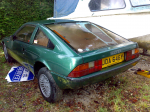|
|
|
|
|
|
|
|
|
|
JL
Sr. Member
   
Posts: 255

|
 |
« Reply #5 on: May 18, 2009, 02:51:33 pm » |
|
Hi Oskar thanks for the information, because of the past moisture in the fibreglass problems I am doing all preparation dry and the website says wash with detergent and then allow to dry - you cannot win!
Krede you are quite correct about the dangers of 2 pack paints, I am sorting out an air fed mask. Out of interest here is some information from our Health and Safety Executive on 2 pack paints. Happy reading!
Regards
John
working with 2-pack isocyanate paints, safety in motor vehicle repair
Introduction: 2-pack paints, in which isocyanate hardener
or activator is added to a pigmented or clear base component, are used
extensively in motor vehicle repair (MVR) for repainting/refinishing vehicles.
This guidance is aimed at employers, self-employed people, supervisors and employees involved in spray, brush or roller painting of motor vehicle body panels. It explains how exposure to isocyanates in 2-pack paints could affect
workers’ health, and outlines some of the precautions that can be taken to protect against the main risks.
What are the dangers?
Exposure to isocyanates can cause long-term and lifethreatening illness. There is a risk if unreacted isocyanate is breathed in, or splashed onto the skin or into the eyes.
Vapours, spray mists, and dusts containing isocyanates are highly irritant to the respiratory tract and eyes, and may cause or worsen existing asthma, or dermatitis.
Working with 2-pack paints can lead to (allergic) sensitisation to isocyanates. Once someone is sensitised, further exposure to even very small amounts of isocyanates can start an asthma attack. Attacks can take place immediately or be delayed for up to 12 hours after exposure, so the symptoms may occur away from work. Early signs of sensitisation may be runny/itchy eyes or nose, developing later into a wheeze,
chest tightness, breathlessness or coughing. Isocyanates are present in the hardener in two forms, monomer and prepolymer, as well as in mixed paint, before
curing.
‘Risk Phrases’ on the paint supplier’s Safety data sheet will identify any health hazards, eg:
● Asthma - by breathing in isocyanate vapour or mist
R42: may cause sensitisation by inhalation
● Dermatitis - from skin contact with the paint or
component chemicals
R43: may cause sensitisation by skin contact
● Conjunctivitis - from splashes to the eye
R36: irritating to eyes
|
|
|
|
|
 Logged
Logged
|
|
|
|
JL
Sr. Member
   
Posts: 255

|
 |
« Reply #6 on: May 18, 2009, 03:28:29 pm » |
|
|
|
|
|
|
 Logged
Logged
|
|
|
|
|
|
|
|
|
|
|
|
